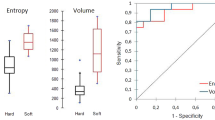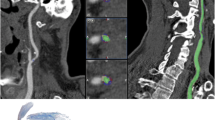Abstract
Purpose
To assess the potential role of computed tomography (CT) texture analysis (CTTA) in identifying vulnerable patients with carotid artery atherosclerosis.
Methods
In this case-control pilot study, 12 patients with carotid atherosclerosis and a subsequent history of transient ischemic attack or stroke were age and sex matched with 12 control cases with asymptomatic carotid atherosclerosis (follow-up time 103.58 ± 9.2 months). CTTA was performed using a commercially available research software package (TexRAD) by an operator blinded to clinical data. CTTA comprised a filtration-histogram technique to extract features at different scales corresponding to spatial scale filter (fine = 2 mm, medium = 3 mm, coarse = 4 mm), followed by quantification using histogram-based statistical parameters: mean, kurtosis, skewness, entropy, standard deviation, and mean value of positive pixels. A single axial slice was selected to best represent the largest cross-section of the carotid bifurcation or the greatest degree of stenosis, in presence of an atherosclerotic plaque, on each side.
Results
CTTA revealed a statistically significant difference in skewness between symptomatic and asymptomatic patients at the medium (0.22 ± 0.35 vs − 0.18 ± 0.39, p < 0.001) and coarse (0.23 ± 0.22 vs 0.03 ± 0.29, p = 0.003) texture scales. At the fine-texture scale, skewness (0.20 ± 0.59 vs − 0.18 ± 0.58, p = 0.009) and standard deviation (366.11 ± 117.19 vs 300.37 ± 82.51, p = 0.03) were significant before correction.
Conclusion
Our pilot study highlights the potential of CTTA to identify vulnerable patients in stroke and TIA. CT texture may have the potential to act as a novel risk stratification tool in patients with carotid atherosclerosis.





Similar content being viewed by others
Data availability
The data underlying this article will be shared on reasonable request to the corresponding author.
References
Mortality and Causes of Death Collaborators (2015) Global, regional and national levels of age-specific mortality and 240 causes of death, 1990-2013 : A systematic analysis for the Global Burden of Disease Study 2013. Lancet 385:117–71. https://doi.org/10.1016/S0140-6736(14)61682-2
Levy EI, Mocco J, Samuelson RM, Ecker RD, Jahromi BS, Hopkins LN (2008) Optimal treatment of carotid artery disease. J Am Coll Cardiol 51:979–985. https://doi.org/10.1016/j.jacc.2007.10.052
ESCT (1991) MRC European Carotid Surgery Trial: interim results for symptomatic patients with severe (70-99%) or with mild (0-29%) carotid stenosis. European Carotid Surgery Trialists’ Collaborative Group. Lancet 337:1235–1243
NASCET (1991) Beneficial effect of carotid endarterectomy in sympotamatic patients with high-grade carotid stenosis. N Engl J Med 325:445–453
Naylor AR, Ricco JB, de Borst GJ, Debus S, de Haro J, Halliday A, Hamilton G, Kakisis J, Kakkos S, Lepidi S, Markus HS, McCabe DJ, Roy J, Sillesen H, van den Berg JC, Vermassen F, ESVS Guidelines Committee, Kolh P, Chakfe N, Hinchliffe RJ, Koncar I, Lindholt JS, Vega de Ceniga M, Verzini F, ESVS Guideline Reviewers, Archie J, Bellmunt S, Chaudhuri A, Koelemay M, Lindahl AK, Padberg F, Venermo M (2018) Editor’s Choice – management of atherosclerotic carotid and vertebral artery disease: 2017 Clinical Practice Guidelines of the European Society for Vascular Surgery (ESVS). Eur J Vasc Endovasc Surg 55:3–81. https://doi.org/10.1016/j.ejvs.2017.06.021
Barnett JMH, Taylor WD, Eliasziw M et al (1998) Benefit of carotid endarterectomy in patients with symptomatic moderate or severe stenosis. N Engl J Med 339:1415–1425
Naghavi M, Libby P, Falk E, Casscells SW, Litovsky S, Rumberger J, Badimon JJ, Stefanadis C, Moreno P, Pasterkamp G, Fayad Z, Stone PH, Waxman S, Raggi P, Madjid M, Zarrabi A, Burke A, Yuan C, Fitzgerald PJ, Siscovick DS, de Korte CL, Aikawa M, Airaksinen KEJ, Assmann G, Becker CR, Chesebro JH, Farb A, Galis ZS, Jackson C, Jang IK, Koenig W, Lodder RA, March K, Demirovic J, Navab M, Priori SG, Rekhter MD, Bahr R, Grundy SM, Mehran R, Colombo A, Boerwinkle E, Ballantyne C, Insull W Jr, Schwartz RS, Vogel R, Serruys PW, Hansson GK, Faxon DP, Kaul S, Drexler H, Greenland P, Muller JE, Virmani R, Ridker PM, Zipes DP, Shah PK, Willerson JT (2003) From vulnerable plaque to vulnerable patient: a call for new definitions and risk assessment strategies: Part I. Circulation 108:1664–1772. https://doi.org/10.1161/01.CIR.0000087481.55887.C9
Teng Z, Sadat U, Brown AJ, Gillard JH (2014) Plaque hemorrhage in carotid artery disease: pathogenesis, clinical and biomechanical considerations. J Biomech 47:847–858. https://doi.org/10.1016/j.jbiomech.2014.01.013
Stary HC (2000) Natural history and histological classification of atherosclerotic lesions: an update. Arterioscler Thromb Vasc Biol 20:1177–1178
Stary HC, Chandler AB, Dinsmore RE, Fuster V, Glagov S, Insull W Jr, Rosenfeld ME, Schwartz CJ, Wagner WD, Wissler RW (1995) A definition of advanced types of atherosclerotic lesions and a histological classification of atherosclerosis. A report from the Committee on Vascular Lesions of the Council on Arteriosclerosis, American Heart Association. Circulation 92:1355–1374
Dweck MR, Maurovich-Horvat P, Leiner T, et al (2020) Contemporary rationale for non-invasive imaging of adverse coronary plaque features to identify the vulnerable patient: a Position Paper from the European Society of Cardiology Working Group on Atherosclerosis and Vascular Biology and the European Associa. Eur Hear J - Cardiovasc Imaging 1–7. https://doi.org/10.1093/ehjci/jeaa201
Sillesen H, Sartori S, Sandholt B, Baber U, Mehran R, Fuster V (2018) Carotid plaque thickness and carotid plaque burden predict future cardiovascular events in asymptomatic adult Americans. Eur Heart J Cardiovasc Imaging 19:1042–1050. https://doi.org/10.1093/ehjci/jex239
Anzidei M, Napoli A, Zaccagna F, di Paolo P, Saba L, Cavallo Marincola B, Zini C, Cartocci G, di Mare L, Catalano C, Passariello R (2012) Diagnostic accuracy of colour Doppler ultrasonography, CT angiography and blood-pool-enhanced MR angiography in assessing carotid stenosis : a comparative study with DSA in 170 patients. Radiol Med 117:54–71. https://doi.org/10.1007/s11547-011-0651-3
Chappell FM, Wardlaw JM, Young GR, Gillard JH, Roditi GH, Yip B, Pell JP, Rothwell PM, Brown MM, Gough MJ, Randall MS (2009) Carotid artery stenosis: accuracy of noninvasive tests--individual patient data meta-analysis. Radiology 251:493–502. https://doi.org/10.1148/radiol.2512080284
Wintermark M, Jawadi SS, Rapp JH, Tihan T, Tong E, Glidden DV, Abedin S, Schaeffer S, Acevedo-Bolton G, Boudignon B, Orwoll B, Pan X, Saloner D (2008) High-resolution CT imaging of carotid artery atherosclerotic plaques. AJNR Am J Neuroradiol 29:875–882. https://doi.org/10.3174/ajnr.A0950
De Weert TT, Ouhlous M, Meijering E et al (2006) In vivo characterization and quantification of atherosclerotic carotid plaque components with multidetector computed tomography and histopathological correlation. Arterioscler Thromb Vasc Biol 26:2366–2372. https://doi.org/10.1161/01.ATV.0000240518.90124.57
Miles KA, Ganeshan B, Hayball MP (2013) CT texture analysis using the filtration-histogram method: what do the measurements mean? Cancer Imaging 13:400–6. 10.1102/1470-7330.2013.9045
Bharati MH, Liu JJ, MacGregor JF (2004) Image texture analysis: methods and comparisons. Chemom Intell Lab Syst 72:57–71. https://doi.org/10.1016/j.chemolab.2004.02.005
García G, Maiora J, Tapia A, De Blas M (2012) Evaluation of texture for classification of abdominal aortic aneurysm after endovascular repair. J Digit Imaging 25:369–376. https://doi.org/10.1007/s10278-011-9417-7
Kotze CW, Rudd JHF, Ganeshan B, Menezes LJ, Brookes J, Agu O, Yusuf SW, Groves AM (2014) CT signal heterogeneity of abdominal aortic aneurysm as a possible predictive biomarker for expansion. Atherosclerosis 233:510–517. https://doi.org/10.1016/j.atherosclerosis.2014.01.001
Ding N, Hao Y, Wang Z, Xuan X, Kong L, Xue H, Jin Z (2020) CT texture analysis predicts abdominal aortic aneurysm post-endovascular aortic aneurysm repair progression. Sci Rep 10:1–10. https://doi.org/10.1038/s41598-020-69226-1
Acharya UR, Sree SV, Mookiah MRK, Saba L, Gao H, Mallarini G, Suri JS (2013) Computed tomography carotid wall plaque characterization using a combination of discrete wavelet transform and texture features: a pilot study. Proc Inst Mech Eng Part H J Eng Med 227:643–654. https://doi.org/10.1177/0954411913480622
Napoli A, Anzidei M, Francone M, Cavallo Marincola B, Carbone I, Geiger D, Zaccagna F, di Paolo PL, Zini C, Catalano C, Passariello R (2008) 64-MDCT imaging of the coronary arteries and systemic arterial vascular tree in a single examination: optimisation of the scan protocol and contrast-agent administration. Radiol Med 113:799–816. https://doi.org/10.1007/s11547-008-0304-3
Arca M, Pigna G, Zaccagna F, Cavallo Marincola B, Montali A, Iuliano L, Napoli A, Catalano C (2010) Atherosclerotic burden In asymptomatic patients with metabolic syndrome evaluated by computed tomography angiography. Atheroscler Suppl 11:18. https://doi.org/10.1016/S1567-5688(10)70076-3
Pigna G, Napoli A, Zaccagna F, Marincola BC, Monticolo R, Catalano C, Iuliano L, Arca M (2011) The relationship between metabolic syndrome, its components, and the whole-body atherosclerotic disease burden as measured by computed tomography angiography. Atherosclerosis 215:417–420
Ganeshan B, Panayiotou E, Burnand K, Dizdarevic S, Miles K (2012) Tumour heterogeneity in non-small cell lung carcinoma assessed by CT texture analysis: a potential marker of survival. Eur Radiol 22:796–802. https://doi.org/10.1007/s00330-011-2319-8
Goh V, Ganeshan B, Nathan P, Juttla JK, Vinayan A, Miles KA (2011) Assessment of response to tyrosine kinase inhibitors in metastatic renal cell cancer: CT texture as a predictive biomarker. Radiology 261:165–171. https://doi.org/10.1148/radiol.11110264
Miles KA, Ganeshan B, Griffiths MR, Young RCD, Chatwin CR (2009) Colorectal cancer: texture analysis of portal phase hepatic CT images as a potential marker of survival. Radiology 250:444–452. https://doi.org/10.1148/radiol.2502071879
Benjamini Y, Hochberg Y (1995) Controlling the false discovery rate : a practical and powerful approach to multiple testing. J R Stat Soc 57:289–300
McDonald JH (2014) Handbook of Biological Statistics, 3rd edn. Sparky House Publishing, Baltimore, Maryland
Golledge J, Greenhalgh RM, Davies AH (2000) The Symptomatic carotid plaque. 774–781
Nicolaides AN, Kakkos SK, Kyriacou E, et al (2010) Asymptomatic internal carotid artery stenosis and cerebrovascular risk stratification. J Vasc Surg 52:1486-1496.e5. https://doi.org/10.1016/j.jvs.2010.07.021
Kyriacou EC, Petroudi S, Pattichis CS, Pattichis MS, Griffin M, Kakkos S, Nicolaides A (2012) Prediction of high-risk asymptomatic carotid plaques based on ultrasonic image features. IEEE Trans Inf Technol Biomed 16:966–973. https://doi.org/10.1109/TITB.2012.2192446
van Engelen A, Wannarong T, Parraga G, Niessen WJ, Fenster A, Spence JD, de Bruijne M (2014) Three-dimensional carotid ultrasound plaque texture predicts vascular events. Stroke 45:2695–2701. https://doi.org/10.1161/STROKEAHA.114.005752
Nyman E, Lindqvist P, Näslund U, Grönlund C (2018) Risk marker variability in subclinical carotid plaques based on ultrasound is influenced by cardiac phase, echogenicity and size. Ultrasound Med Biol 44:1742–1750. https://doi.org/10.1016/j.ultrasmedbio.2018.03.013
Loizou CP, Pattichis CS, Pantziaris M et al (2016) Texture features variability in ultrasound video of atherosclerotic carotid plaques. IFMBE Proc 57:351–354. https://doi.org/10.1007/978-3-319-32703-7_69
Kyriacou E, Christofides S, Pattichis CS (2016) A mathematical model of discharge coefficient for prosthetic valves’ performance evaluation. IFMBE Proc 57:688–693. https://doi.org/10.1007/978-3-319-32703-7
Rothwell PM, Villagra R, Gibson R, Donders RCJM, Warlow CP (2000) Evidence of a chronic systemic cause of instability of atherosclerotic plaques. Lancet 355:19–24. https://doi.org/10.1016/S0140-6736(99)04470-0
Funding
This pilot study was funded by University of Rome—Sapienza, project “Avvio alla Ricerca.” Some of the co-authors from University College London Hospital/University College London (UCLH/UCL) received a proportion of the funding from the UK’s Department of Health’s National Institute of Health Research, Biomedical Research Centre’s funding scheme.
Author information
Authors and Affiliations
Contributions
All authors contributed to the study conception and design. Material preparation, data collection, and analysis were performed by Fulvio Zaccagna and Balaji Ganeshan. The first draft of the manuscript was written by Fulvio Zaccagna and all authors commented on previous versions of the manuscript. All authors read and approved the final manuscript.
Corresponding author
Ethics declarations
Conflict of interest
Balaji Ganeshan is the Co-Founder/Co-Inventor of TexRAD texture analysis software used in this study and a shareholder (not an employee) of Feedback Plc., a UK-based company which owns, develops, and markets the TexRAD texture analysis software. All the other authors have no relevant financial or non-financial interests to disclose.
Ethical approval
All procedures performed in studies involving human participants were in accordance with the ethical standards of the institutional and/or national research committee and with the 1964 Helsinki declaration and its later amendments or comparable ethical standards.
Consent to participate
Informed consent was obtained from all individual participants included in the study as part of previous IRB-approved studies conducted at our institution.
Code availability
We used a proprietary research software algorithm commercially available for research purposes.
Additional information
Publisher’s note
Springer Nature remains neutral with regard to jurisdictional claims in published maps and institutional affiliations.
Rights and permissions
About this article
Cite this article
Zaccagna, F., Ganeshan, B., Arca, M. et al. CT texture-based radiomics analysis of carotid arteries identifies vulnerable patients: a preliminary outcome study. Neuroradiology 63, 1043–1052 (2021). https://doi.org/10.1007/s00234-020-02628-0
Received:
Accepted:
Published:
Issue Date:
DOI: https://doi.org/10.1007/s00234-020-02628-0




